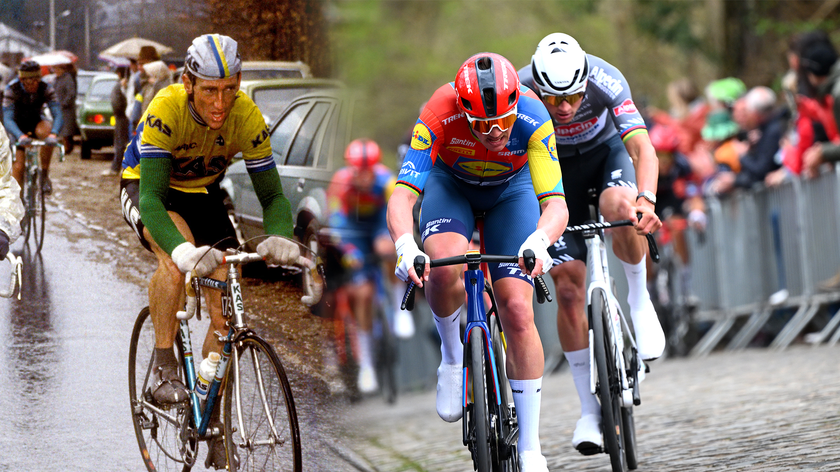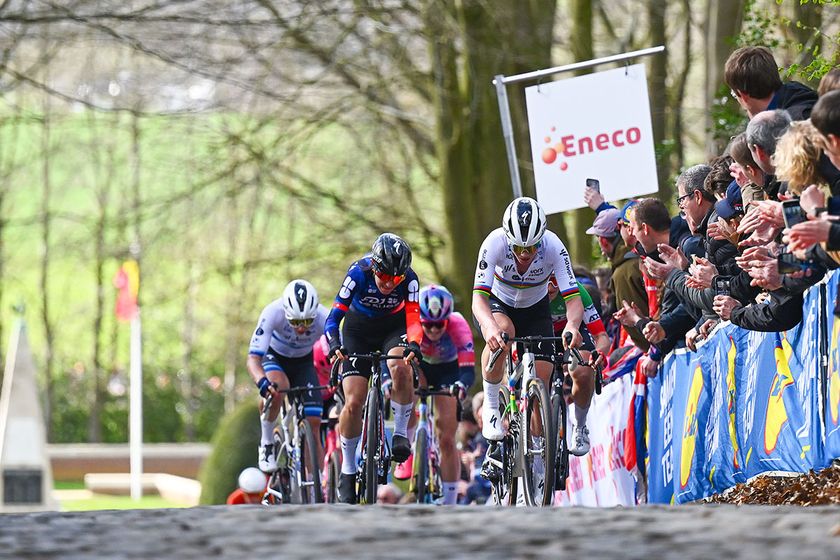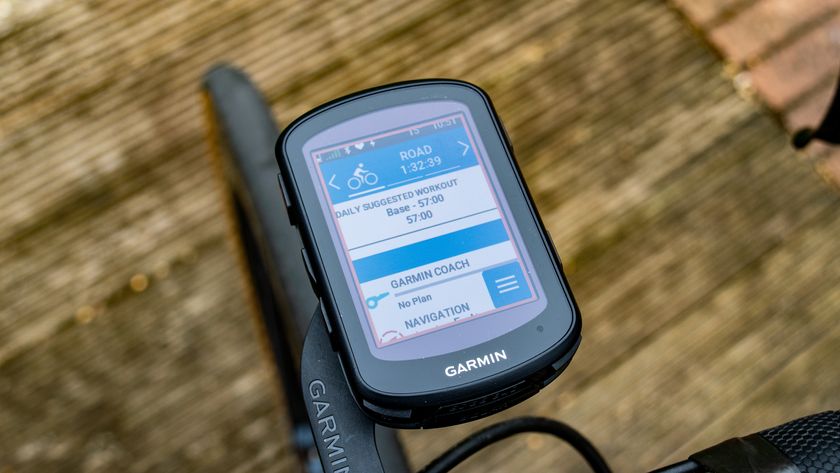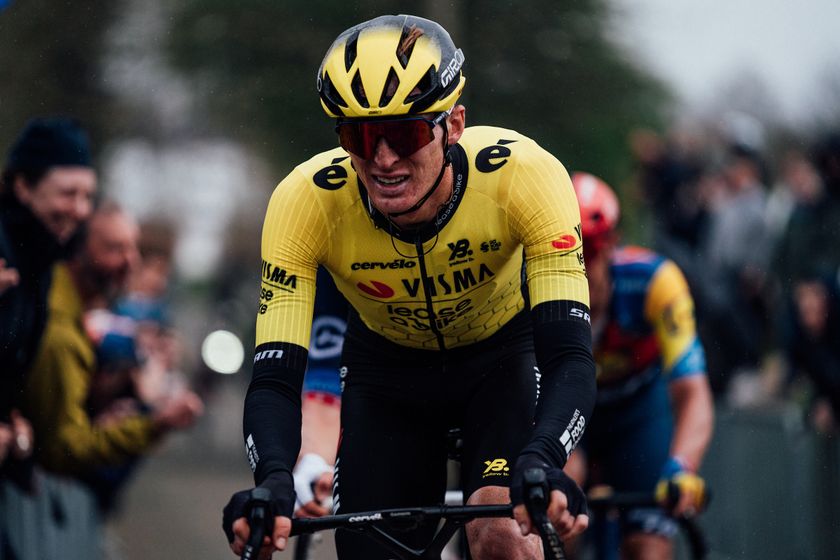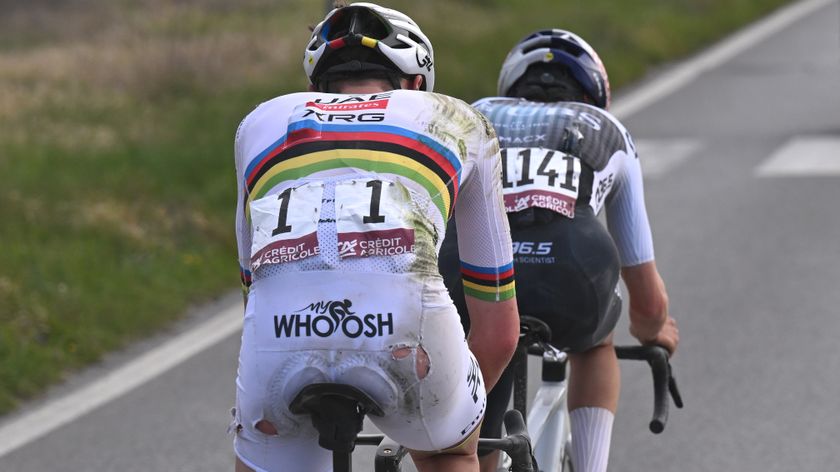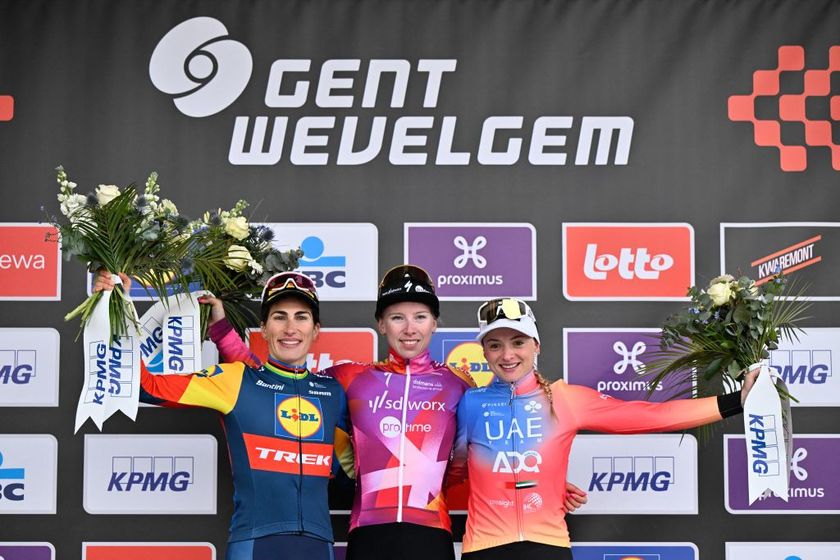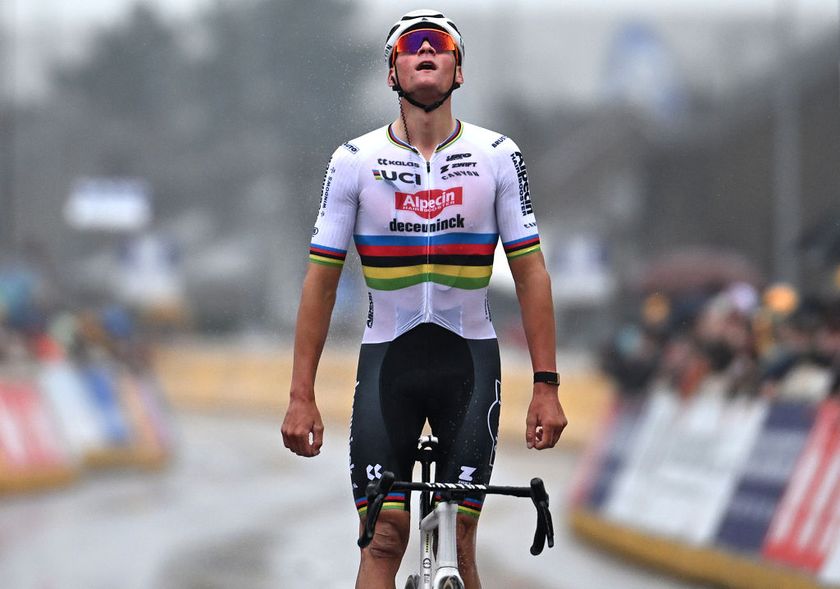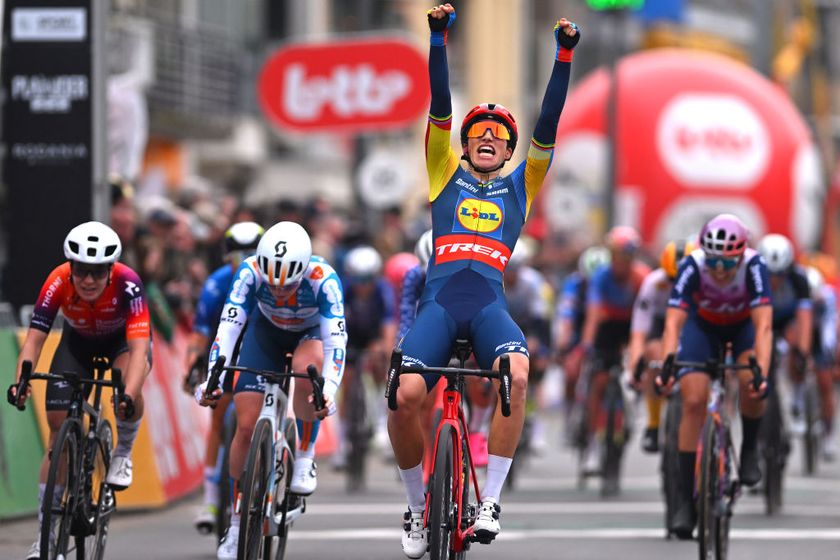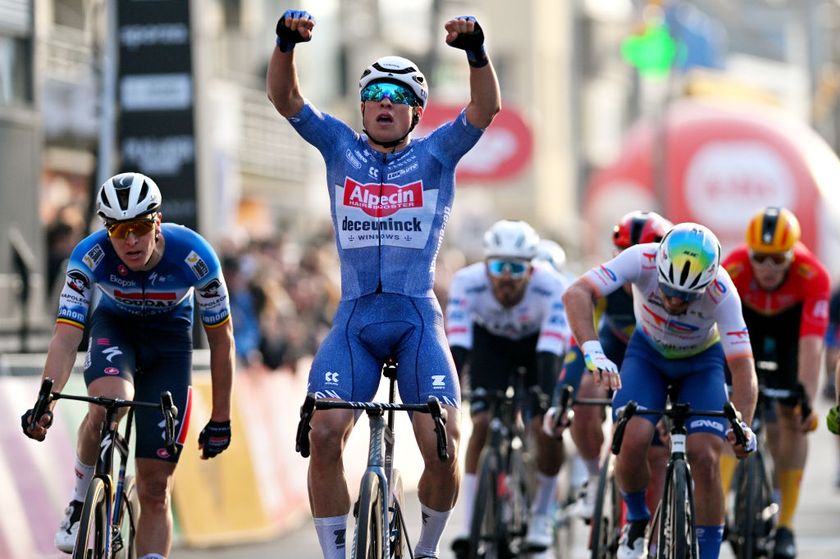Fitness questions and answers for April 5, 2004
Got a question about fitness, training, recovery from injury or a related subject? Drop us a line at...
Form & Fitness Q & A
Got a question about fitness, training, recovery from injury or a related subject? Drop us a line at fitness@cyclingnews.com. Please include as much information about yourself as possible, including your age, sex, and type of racing or riding.
Carrie Cheadle, MA (www.carriecheadle.com) is a Sports Psychology consultant who has dedicated her career to helping athletes of all ages and abilities perform to their potential. Carrie specialises in working with cyclists, in disciplines ranging from track racing to mountain biking. She holds a bachelors degree in Psychology from Sonoma State University as well as a masters degree in Sport Psychology from John F. Kennedy University.
Dave Palese (www.davepalese.com) is a USA Cycling licensed coach and masters' class road racer with 16 years' race experience. He coaches racers and riders of all abilities from his home in southern Maine, USA, where he lives with his wife Sheryl, daughter Molly, and two cats, Miranda and Mu-Mu.
Kelby Bethards, MD received a Bachelor of Science in Electrical Engineering from Iowa State University (1994) before obtaining an M.D. from the University of Iowa College of Medicine in 2000. Has been a racing cyclist 'on and off' for 20 years, and when time allows, he races Cat 3 and 35+. He is a team physician for two local Ft Collins, CO, teams, and currently works Family Practice in multiple settings: rural, urgent care, inpatient and the like.
Fiona Lockhart (www.trainright.com) is a USA Cycling Expert Coach, and holds certifications from USA Weightlifting (Sports Performance Coach), the National Strength and Conditioning Association (Certified Strength and Conditioning Coach), and the National Academy for Sports Nutrition (Primary Sports Nutritionist). She is the Sports Science Editor for Carmichael Training Systems, and has been working in the strength and conditioning and endurance sports fields for over 10 years; she's also a competitive mountain biker.
Eddie Monnier (www.velo-fit.com) is a USA Cycling certified Elite Coach and a Category II racer. He holds undergraduate degrees in anthropology (with departmental honors) and philosophy from Emory University and an MBA from The Wharton School of Business.
Eddie is a proponent of training with power. He coaches cyclists (track, road and mountain bike) of all abilities and with wide ranging goals (with and without power meters). He uses internet tools to coach riders from any geography.
Get The Leadout Newsletter
The latest race content, interviews, features, reviews and expert buying guides, direct to your inbox!
David Fleckenstein, MPT (www.physiopt.com) is a physical therapist practicing in Boise, ID. His clients have included World and U.S. champions, Olympic athletes and numerous professional athletes. He received his B.S. in Biology/Genetics from Penn State and his Master's degree in Physical Therapy from Emory University. He specializes in manual medicine treatment and specific retraining of spine and joint stabilization musculature. He is a former Cat I road racer and Expert mountain biker.
Since 1986 Steve Hogg (www.cyclefitcentre.com) has owned and operated Pedal Pushers, a cycle shop specialising in rider positioning and custom bicycles. In that time he has positioned riders from all cycling disciplines and of all levels of ability with every concievable cycling problem.They include World and National champions at one end of the performance spectrum to amputees and people with disabilities at the other end.
Current riders that Steve has positioned include Davitamon-Lotto's Nick Gates, Discovery's Hayden Roulston, National Road Series champion, Jessica Ridder and National and State Time Trial champion, Peter Milostic.
Pamela Hinton has a bachelor's degree in Molecular Biology and a doctoral degree in Nutritional Sciences, both from the University of Wisconsin-Madison. She did postdoctoral training at Cornell University and is now an assistant professor of Nutritional Sciences at the University of Missouri-Columbia where she studies the effects of iron deficiency on adaptations to endurance training and the consequences of exercise-associated changes in menstrual function on bone health.
Pam was an All-American in track while at the UW. She started cycling competitively in 2003 and is the defending Missouri State Road Champion. Pam writes a nutrition column for Giana Roberge's Team Speed Queen Newsletter.
Dario Fredrick (www.wholeathlete.com) is an exercise physiologist and head coach for Whole Athlete™. He is a former category 1 & semi-pro MTB racer. Dario holds a masters degree in exercise science and a bachelors in sport psychology.
Scott Saifer (www.wenzelcoaching.com) has a Masters Degree in exercise physiology and sports psychology and has personally coached over 300 athletes of all levels in his 10 years of coaching with Wenzel Coaching.
Kendra Wenzel (www.wenzelcoaching.com) is a head coach with Wenzel Coaching with 17 years of racing and coaching experience and is coauthor of the book Bike Racing 101.
Steve Owens (www.coloradopremiertraining.com) is a USA Cycling certified coach, exercise physiologist and owner of Colorado Premier Training. Steve has worked with both the United States Olympic Committee and Guatemalan Olympic Committee as an Exercise Physiologist. He holds a B.S. in Exercise & Sports Science and currently works with multiple national champions, professionals and World Cup level cyclists.
Through his highly customized online training format, Steve and his handpicked team of coaches at Colorado Premier Training work with cyclists and multisport athletes around the world.
Brett Aitken (www.cycle2max.com) is a Sydney Olympic gold medalist. Born in Adelaide, Australia in 1971, Brett got into cycling through the cult sport of cycle speedway before crossing over into road and track racing. Since winning Olympic gold in the Madison with Scott McGrory, Brett has been working on his coaching business and his www.cycle2max.com website.
Richard Stern (www.cyclecoach.com) is Head Coach of Richard Stern Training, a Level 3 Coach with the Association of British Cycling Coaches, a Sports Scientist, and a writer. He has been professionally coaching cyclists and triathletes since 1998 at all levels from professional to recreational. He is a leading expert in coaching with power output and all power meters. Richard has been a competitive cyclist for 20 years
Andy Bloomer (www.cyclecoach.com) is an Associate Coach and sport scientist with Richard Stern Training. He is a member of the Association of British Cycling Coaches (ABCC) and a member of the British Association of Sport and Exercise Sciences (BASES). In his role as Exercise Physiologist at Staffordshire University Sports Performance Centre, he has conducted physiological testing and offered training and coaching advice to athletes from all sports for the past 4 years. Andy has been a competitive cyclist for many years.
Michael Smartt (www.cyclecoach.com) is an Associate Coach with Richard Stern Training. He holds a Masters degree in exercise physiology and is USA Cycling Expert Coach. Michael has been a competitive cyclist for over 10 years and has experience coaching road and off-road cyclists, triathletes and Paralympians.
Kim Morrow (www.elitefitcoach.com) has competed as a Professional Cyclist and Triathlete, is a certified USA Cycling Elite Coach, a 4-time U.S. Masters National Road Race Champion, and a Fitness Professional.
Her coaching group, eliteFITcoach, is based out of the Southeastern United States, although they coach athletes across North America. Kim also owns MyEnduranceCoach.com, a resource for cyclists, multisport athletes & endurance coaches around the globe, specializing in helping cycling and multisport athletes find a coach.
Cadence vs cadence
Power test
Road bike
New saddle break-in
Mucus
Sprinters are all-rounders
Cadence vs cadence
Daylight saving has come to a close for another year here in Australia which means less daylight hours for cycling and a resulting increase in indoor cycling sessions. My indoor machine is a Repco Bionic (with fan resistance) and my usual indoor session comprises a 10 - 15 minute warm up and cool-down with 5x5 minute intervals at a perceived 90 percent MHR (no HRM) interspersed with 5 minute active rest sessions (approx 65 percent MHR).
I'm a recreational cyclist whose aim is to improve my performance so I can hang with the faster guys in our weekly 50 - 80 km group ride over a course that is part flat (coastal), part undulating and includes several 3 - 4km hills (5 - 5.5 percent ave. gradient). Apart from the group ride each week I usually do 1 indoor session (as above), 1 outdoor session (1 hr over an undulating course) and if I can manage it a third session which could be either indoors or outdoors depending on the season.
While this routine has improved my fitness and speed somewhat I struggle to stay with the faster bunch (they're getting faster and fitter as well). At 47, 195 cm, 95kg and 17 percent body fat I'm one of the older, bigger and leaner guys in the group. I think one of the problems with my training routine is that my cadence to maintain 90 percent MHR on the exercise bike is only about 80 - 85 RPM while my road riding cadence is more like 90 - 110 RPM. Is this really likely to be a significant factor? Do you think I would be better off removing some of the fan blades so that the cadence of the indoor sessions is closer to my road riding cadence?
Steve Gunn
Adelaide, Sth Australia
Brett Aitken replies:
The small cadence difference between the ergo training and road is going to have very little bearing on your performance. The focus should be more on the power output and the structure of your training program/routines and how you could make better use of the other two sessions in the week.
Dario Fredrick replies:
In addition to Brett's sage advice, I would like to add that the difference in your position between the Repco stationary bike and your road bike may be significant. Muscular training adaptations are very specific to the position in which they are trained, and may not transfer that well between the stationary bike and your road bike. Unless the position of your pelvis in relation to the bottom bracket (saddle height & setback), and the forward rotated angle of the pelvis on both bikes is very similar, the full training benefits from one will not transfer to the other. Crank length should ideally be the same between both bikes as well.
Power Test
I would like to start to train based on power. I have already read your article about the power test, but I just have as a power-meter tool the new Tacx Trainer which gives me actual power, max power and average power. Do you think that with this data I can properly conduct a power test in order to define my 8 zones of training?
Carlos Garza
Ric Stern replies:
I'm not overly familiar with the new Tacx trainer, so I'm not sure if the data it generates is downloadable to a PC and whether you can manipulate the data or not -- as you're looking for the highest average power over 60 seconds. This often corresponds with the final 60 seconds, but sometimes power will start to decrease prior to the rider stopping and you may need to backtrack a little to get the highest 60 seconds.
Road bike
I just want to know if having a road bike makes a big difference in your speed. I currently have a great, fairly light, mountain bike and am riding very well with it. I am wondering if I should buy a road bike, but only if it will make a big difference in my speed and overall riding.
Scott Saifer replies:
Several years ago I worked with a charity organization that prepared beginning and intermediate riders for 100-mile bike rides. Many of the participants switched from mountain to road bikes at mid-season, so I can say with some certainty that the difference in speed for the same effort between a MTB with fat tires and an upright riding position on the one hand and a skinny-tire road with a low riding position on the other hand is about 4 mph (6 kph) if your speed before switching is in the low teens mph or a little under 20 kph. The faster you ride before the switch, the bigger the difference the switch will make. This difference is large enough that it is virtually impossible to be competitive on a MTB in a road race. If you are competitive on a MTB in a road race, that just means you should be riding against stronger riders. You can partly overcome the disadvantage of the MTB by putting on very skinny slick tires and riding in a crouched, stretched out position.
New Saddle Break-in
I am a 41 year-old recreational road rider, 6ft (183 cm), 170lb (77 kg), who primarily trains for "challenge century" rides: 100+ miles (160 km) with 10,000+ feet (3300 m) of climbing. I recently purchased a new saddle because my old one, while very comfortable for these long rides, had worn out in the nose area and was starting to ruin my cycling shorts. The new saddle has more of a racing profile - long narrow front, less generous back padding - than the old, and both have a center cut-out for "soft tissue relief." I installed the new saddle in the same position as the old one, and have been using it for about a week now (8 hours total riding time).
My question is: how long should I endure the discomfort before (1) making a position change (fore/aft, height, tilt), or (2) give up and try another saddle? The discomfort is strictly at the contact points between my body and the back part of the saddle, is not severe, and is temporarily relieved by standing up for a several seconds. Although the pain has not significantly affected my training so far, I would not want to use the new saddle on an all-day ride at this point.
[In case the panel want to know more specifics: the old saddle is a WTB Speed V, and the new is a Selle Italia Max Flite Gel Flow.]
Paul Washburn
Blacksburg, VA, USA
Scott Saifer replies:
Unlike older all-leather saddles, modern saddles with a plastic shell and leather cover have virtually no break in period. I'd suggest trying to adjust the position immediately and if you do not find relief, get a different saddle. Because different saddles have different shapes, you will sit on them differently, meaning that setting an identical saddle height and set-back measured to the saddle nose will not necessarily put you in the same position on two different saddles.
Mucus
I'm a 41 year old fit and healthy intermediate road cyclist, 6 feet tall for 165 pounds. I have a resting heart rate of 44 and max out at 172. I've been riding more or less for fun and fitness since my early 20's, but four years ago, I got the racing bug really bad. I take part in about 7 to 8 "cyclosportives" races (125km long timed group races that focus mainly on friendly competition) every summer and do them mostly for the fun and camaraderie. As for training, I've read many article, books and sought the advice from a variety of sources (including cyclingnews...) to get a basic idea of how to train and what to eat. I favour LSD, long slow distance, to start the season, then gradually incorporate thougher and more demanding rides as I get fitter. I eat a well balanced diet of lean meats, fresh fruits and veggies and an adequate amount of carbs.
After a long or hard training ride (or race), I always get a lot of mucus in my lungs. I have to clear my throat every few minutes, sometimes for hours, even the next day! I am lactose intolerant, but have taken all dairy products out of my diet for years now. Why does this excess mucus occur after my rides?
Vincent Desmarais
Montréal, Canada
Benoit Nave replies:
The mucus problem you are talking about is quiet common for endurance athletes. The fact that you are lactose intolerant means that your intestine is kind of fragile. You probably have also a slight intolerance to gluten that doesn't cause a problem in your daily life except when you have respiratory infections (throat, nose, lungs, ears) and also when you have your lungs working: when exercising. This intolerance leads to a chronic gut (intestinal) inflammation that allows gluten proteins to get through your intestinal cells. In case you like to eat a lot of wheat products (bread, pasta, even home maid pastries with wheat flour...) and other cereals that contain gluten (oat, barley, rye...), your body might have difficulty metabolizing some of their proteins that are not recognizable by our enzymes.
Sprinters are all-rounders
As a former USCF category I racer, and current physiological consultant to competitive cyclists, in response to your March 29 article titled "Limitations on sprinting," I would like to echo the sentiments of some of your contributors, that sprinting in road cycling is a relative term, and as such, makes it a very trainable skill for most competitive cyclists. As Mr. Aitken pointed out, elite road cyclists, regardless of perceived or stated specialty, are very homogenous in physiological characteristics. All have a predominance of slow twitch muscle fibers, high aerobic capacity and relatively high anaerobic/lactate thresholds. The reason top sprinters like Petacchi, or Cipo can't get over climbs like the Poggio with the front group is that they don't train that way. Similarly, the reason many rouleurs aren't taking sprints is that they don't train that way.
The example Jeff cites in his initial question, that of Lance Armstrong finishing fourth in a group of four is actually an apt example. If you look back over Lance's career, before his battle with cancer, loss of numerous kilos, and focus on results as a GC contender in the big one; he was actually considered a competent sprinter, and was often tipped to win if races came down to a sprint from a small group. Similarly, take Laurent Jalabert, who began his career as a "pure" sprinter. After a horrendous crash soured his taste for the bunch gallop, he became the dominant one day rider (a la Bettini), a world champion time trialist and overall GC contender in the grand tours. So, the line between pure sprinter and the rest of the peloton is often a gray one.
For most recreational racers, or even racers at the more elite level, a major limiting factor to sprinting success is taste, or stomach, for the bunch sprint. If one has the constitution to risk being pushed into a barrier, or touch wheels and touch pavement, they can often be quite successful in field sprints. Whereas, if one is not ready to throw caution to the wind and go elbow to elbow in the fight for wheels in the last 500 m, one will never get results in a sprint. This situation often results in a catch-22, as the most important factor in sprinting, getting and maintaining position, cannot be learned without having a taste or stomach for the bunch sprint, and many racers never get a taste for sprinting until they are successful, which requires getting and maintaining position. You can see the conundrum, one cannot get experience until one has experience. Therefore, although I agree with Jeff's synopsis of fundamental skills (e.g. leg speed, max power etc) that need to be developed in order to become a better sprinter, I also assert that real world scenarios need to be found whereby the fundamental skills can be used in a repetitive fashion to develop the more important skills of position and timing. I think you will find that most average cyclists can become competent sprinters against their contemporaries without developing significantly more power or speed.
If one wishes to improve overall sprinting ability, practice races or group mock criteriums can be used for this purpose. A simple practice race, with twenty experienced participants and sprints every 5 or 10 laps on a criterium course can be worth as much finishing experience as a month of weekend races. The lack of pressure from prize money or upgrade points can give the individual the freedom to try going early, or leaving it late, or even leading it out. Therefore, the individual learns their strengths and weaknesses, and at the same time gains invaluable experience which will instill an innate sense of timing and flow, that is also critical to success at finishing. It should be noted that sprinting against a training partner would do little to reinforce these skills.
These short mock races will also help the individual break the end of the race into critical landmarks. As Ed Monnier pointed out, the sprint in a criterium is really two sprints, one for the last turn, then one for the line. This can be extended to the last kilometer, or last five kilometers of a race, and mock races with repeated finishes consisting of several kilometers will help the racer identify these critical points of the finish of a race through repetition. The crucible of the sprint is the best teaching tool for sprinting and repetition will instill that innate sense of timing necessary to be successful in the sprint, regardless of one's strengths and/or weaknesses.
All of this being said, there will still be some racers who cannot sprint their way out of a paper bag, no matter how much they train or practice. Fortunately for them, they are likely the ones who are aerobic machines and can rip the legs off of a breakaway, and for the most part don't need to sprint.
Stephen J. McGregor, Ph.D.
Assistant Professor of Exercise Science
Eastern Michigan University
